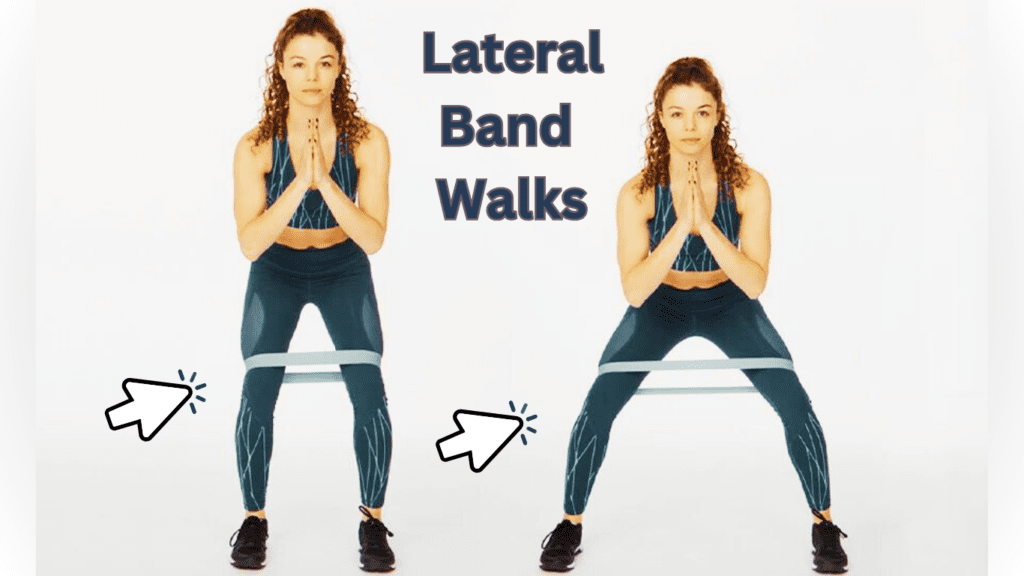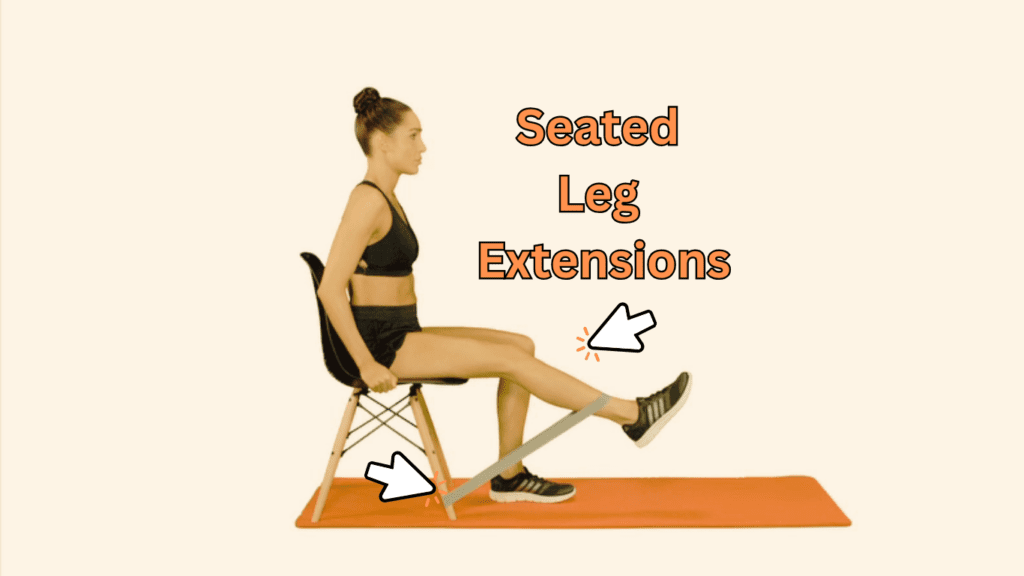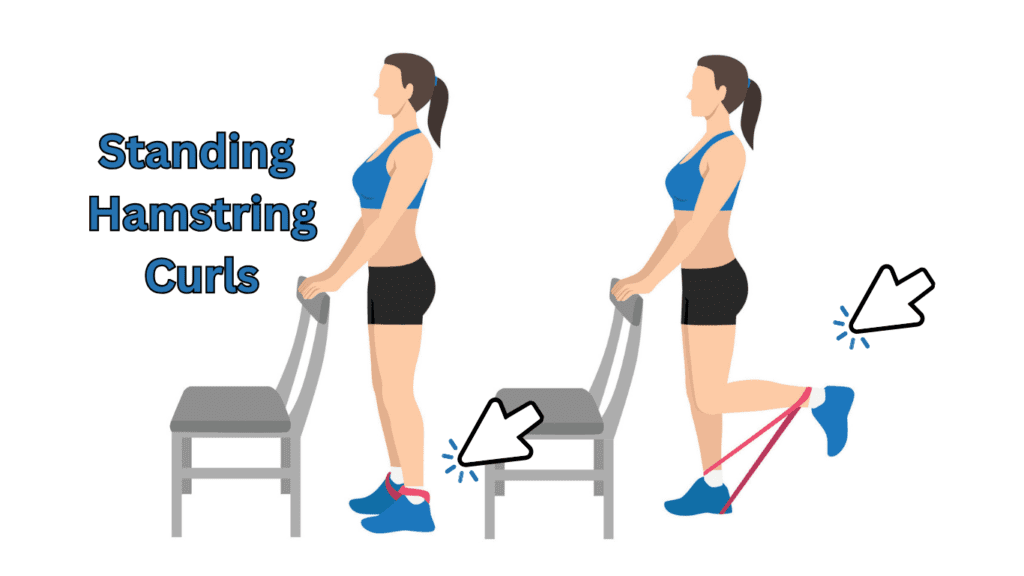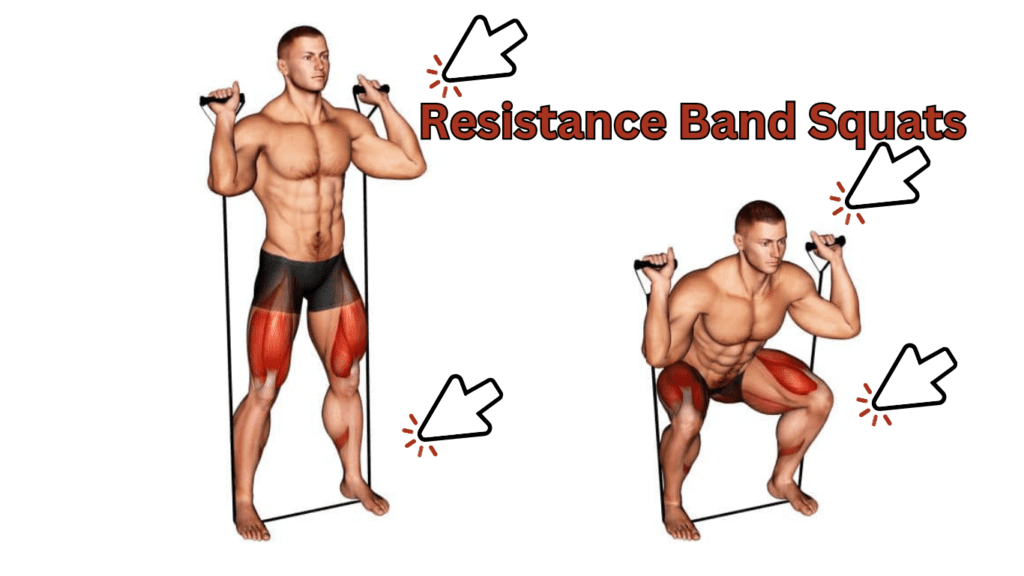Understanding the Importance of Resistance Band Exercises for Knees
In this article, we will discuss the benefits of resistance band exercises for knees and why you should consider incorporating them into your routine.
Have you ever considered how vital your knee health is to your overall wellbeing? As a personal fitness trainer, I’ve seen firsthand how knee issues can impact not only mobility but also the quality of life. Knee problems are incredibly common, affecting people of all ages and activity levels. Whether it’s due to an old sports injury, arthritis, or simply the wear and tear of everyday activities, knee pain can become a significant obstacle.
Maintaining strong and flexible knee joints is essential for keeping up with daily activities and enjoying an active lifestyle. The knees are one of the largest and most complex joints in the body, and they bear a substantial load. Every step, squat, or jump we make relies heavily on the strength and stability of our knees. When they’re weak or inflexible, it can lead to a cascade of problems, including reduced mobility and increased pain. This is why focusing on knee health should be a fundamental part of any fitness routine.

One effective, versatile, and accessible tool that I always recommend for knee exercises is the resistance band. These bands are not only inexpensive and portable, but they also offer a wide range of benefits. The resistance band provides a level of resistance that can help build muscle strength and improve joint stability without putting excessive strain on the knees. This makes them particularly suitable for those recovering from injury or those looking to prevent knee issues from arising in the first place.
Resistance bands come in various levels of resistance, making them adaptable to different fitness levels and goals. They’re excellent for targeting the muscles around the knees, such as the quadriceps, hamstrings, and the often overlooked but crucial muscles of the hips and glutes. Strengthening these supporting muscles can alleviate the stress on the knees and improve overall joint function.
Subscribe And Get Our Free E-Book:Unlocking The Power Of Nutrition-Supplements, Substitutes, and Superfoods!
In my experience, incorporating resistance band exercises for knees into a regular workout routine can yield significant benefits. Not only do they help in strengthening and stabilizing the knees, but they also enhance flexibility and balance. The beauty of using resistance bands is their ability to provide a consistent level of tension throughout the exercise, which is something free weights and machines don’t always offer. This consistent tension ensures that the muscles are engaged throughout the entire range of motion, leading to more effective workouts and better results.
Moreover, resistance bands are incredibly versatile. They can be used for a variety of exercises that can be tailored to target different aspects of knee health. Whether you’re looking to improve strength, flexibility, or rehabilitate after an injury, there’s a resistance band exercise that can help. Plus, because they’re so portable, you can take them anywhere and incorporate knee exercises into your routine without the need for a gym.
As someone who has guided many clients through their fitness journeys, I can attest to the benefits of using resistance bands for knee health. They offer a low-impact yet highly effective way to strengthen and support the knees. This makes them particularly beneficial for individuals of all fitness levels, from beginners to advanced athletes. Whether you’re aiming to enhance your performance in sports, recover from an injury, or simply maintain a healthy and active lifestyle, resistance band exercises for knees should be a staple in your fitness regimen.
Chart: Enhancing Your Understanding of Resistance Band Exercises for Knee Health
| Aspect | Details | Benefits | Tips for Safe Usage |
|---|---|---|---|
| Versatility | Resistance bands offer various resistance levels (light, medium, heavy) suitable for all fitness levels, from beginners to advanced athletes. This adaptability allows for progressive strength training and rehabilitation, catering to diverse knee health needs. | – Allows customization of workouts<br>- Facilitates gradual progression of resistance<br>- Targets specific muscle groups effectively | – Start with bands of appropriate resistance level<br>- Progress gradually to heavier bands as strength improves<br>- Use different bands for different exercises to target various muscle groups |
| Portability | Lightweight and compact, resistance bands are travel-friendly, enabling consistent workouts anywhere – at home, outdoors, or while traveling. This convenience ensures uninterrupted knee health maintenance and rehabilitation without reliance on gym equipment. | – Enables workouts in diverse settings<br>- Convenient for those who travel frequently<br>- Reduces barriers to exercise consistency | – Pack resistance bands for travel to maintain routine<br>- Utilize bands in outdoor spaces for flexibility in workout locations<br>- Store bands in easily accessible places at home to encourage regular use |
| Muscle Engagement | Bands provide constant tension throughout exercises, enhancing muscle activation and stabilization around the knee joint. This sustained engagement improves strength and mobility while minimizing joint stress, making it ideal for recovery and injury prevention. | – Promotes better muscle activation<br>- Enhances joint stability and mobility<br>- Supports rehabilitation after knee injuries | – Focus on maintaining proper form throughout exercises<br>- Ensure bands are securely anchored to prevent slipping<br>- Monitor tension levels to avoid overstretching or snapping |
| Injury Prevention | By strengthening key muscle groups (quadriceps, hamstrings, glutes), resistance band exercises enhance knee stability and reduce the risk of common issues like arthritis and tendinitis. This preventive approach supports long-term joint health and functionality. | – Reduces strain on knee joints<br>- Helps prevent injuries associated with weak muscles<br>- Supports overall joint health | – Consult with a healthcare provider before starting a new exercise regimen, especially if recovering from a knee injury<br>- Incorporate resistance band exercises into a comprehensive fitness routine that includes cardiovascular and flexibility training<br>- Pay attention to signs of discomfort or pain during exercises and adjust technique or resistance level accordingly |
Focusing on knee health is crucial for maintaining overall mobility and quality of life. Knee issues are prevalent, but with the right approach, they can be managed and even prevented. Resistance band exercises for knees are an excellent tool for this purpose, offering versatility, effectiveness, and accessibility. Incorporating them into your routine can lead to stronger, more stable, and more flexible knees, ultimately enhancing your ability to move freely and enjoy life to the fullest.
Understanding Knee Anatomy and Common Issues
When considering the resistance band exercises for knees we introduced earlier, it’s crucial to understand the underlying anatomy and common issues affecting this vital joint. The knee is a complex structure, composed of bones, cartilage, ligaments, and tendons, all working together to provide support and movement.
Starting with the bones, the knee joint involves three main ones: the femur (thigh bone), the tibia (shin bone), and the patella (kneecap). These bones form the skeletal foundation of the knee and play a crucial role in weight-bearing and movement. Next, we have the cartilage, specifically the menisci and the articular cartilage. The menisci are two C-shaped pieces of cartilage that act as shock absorbers between the femur and tibia, while the articular cartilage covers the ends of these bones, allowing for smooth movement.
The knee also relies heavily on ligaments for stability. The major ligaments include the anterior cruciate ligament (ACL), posterior cruciate ligament (PCL), medial collateral ligament (MCL), and lateral collateral ligament (LCL). These ligaments connect the bones of the knee and help control motion, preventing excessive movement that could lead to injury. Finally, tendons, such as the quadriceps tendon and patellar tendon, connect the muscles to the bones, enabling the knee to move and function properly.

Given this intricate anatomy, it’s not surprising that the knee is prone to various issues. Arthritis, for instance, is a common condition where the cartilage wears down, leading to pain, swelling, and reduced mobility. Ligament injuries, such as ACL tears, are often seen in athletes and can result in significant instability and pain. Patellar tendinitis, also known as jumper’s knee, is an inflammation of the patellar tendon, often caused by repetitive stress from activities like running or jumping.
These knee problems can severely impact daily life. Arthritis may make simple tasks like walking or climbing stairs painful and challenging. Ligament injuries can limit one’s ability to participate in sports or even perform routine activities. Patellar tendinitis can cause persistent pain that interferes with everyday movements and physical activities.
This is where the importance of strengthening the muscles around the knee comes into play. By focusing on the quadriceps, hamstrings, and the muscles of the hips and glutes, we can provide better support and stability to the knee joint. Strong muscles help to absorb and distribute the forces exerted on the knee, reducing the strain on the ligaments and cartilage.
Incorporating resistance band exercises for knees is an effective way to achieve this muscle strengthening. Resistance bands provide a safe and controlled form of resistance that can target these crucial muscle groups without putting undue stress on the knee itself. For example, exercises like banded squats or leg presses engage the quadriceps and hamstrings, enhancing their strength and function. This can help prevent injuries by improving the overall stability of the knee joint.
Moreover, using resistance bands can aid in rehabilitating an injured knee. For someone recovering from an ACL injury, gentle resistance band exercises can help rebuild muscle strength and improve joint stability gradually. This approach allows for a controlled and progressive increase in intensity, which is essential for a safe and effective recovery process.
Resistance band exercises for knees are not just beneficial for those with existing knee issues; they are also an excellent preventive measure. By regularly performing these exercises, individuals can maintain strong and flexible knee joints, reducing the risk of developing problems in the future. This proactive approach is especially important for those engaged in activities that place significant stress on the knees, such as running, jumping, or heavy lifting.
As a personal fitness trainer, I’ve seen how incorporating these exercises can transform knee health. Clients who once struggled with pain and mobility issues often experience significant improvements in their ability to perform everyday activities and engage in physical exercise. This enhanced knee function not only boosts their physical health but also their confidence and overall quality of life.
11 Knee Rehab Exercises to Fix Knee Pain, Strengthening After Knee Injury Video
Understanding the anatomy of the knee and the common issues that can affect it highlights the importance of maintaining strong and flexible knee joints. Resistance band exercises for knees offer an effective, versatile, and accessible means to achieve this goal. Whether you’re looking to prevent knee problems, manage an existing condition, or recover from an injury, these exercises can provide the support and strength needed to keep your knees healthy and functional.
Benefits of Resistance Band Exercises for Knees: Versatility, Convenience, and Effective Muscle Engagement
In my experience as a personal fitness trainer, I’ve found that one of the most effective tools for knee exercises is the resistance band. The benefits of using resistance band exercises for knees are numerous and cater to a wide range of fitness levels and goals. Let’s dive into why these bands are so advantageous.
First, let’s talk about the versatility of resistance bands. One of the standout features of these bands is the variety of resistance levels they offer. Whether you’re a beginner just starting your fitness journey or an advanced athlete looking to challenge yourself, there’s a resistance band for you. The bands typically come in light, medium, and heavy resistance levels, allowing you to customize your workouts based on your strength and progress. This adaptability means you can gradually increase the resistance as you build muscle strength, ensuring that your workouts remain effective and challenging over time. For example, starting with a light resistance band for basic knee exercises and progressively moving to a heavier band can help in steadily building strength and stability in the knee joint.
Another significant advantage of resistance band exercises for knees is their portability and convenience. Resistance bands are lightweight and compact, making them easy to carry wherever you go. Whether you’re at home, at the gym, or traveling, you can always bring your resistance bands with you. This portability eliminates the need for bulky gym equipment, allowing you to maintain your fitness routine no matter where you are. I’ve had clients who travel frequently, and they appreciate how resistance bands enable them to keep up with their exercises without needing access to a gym. This convenience ensures that you never miss a workout, which is crucial for maintaining knee strength and health.
The effective muscle engagement provided by resistance bands is another reason I highly recommend them for knee exercises. Unlike free weights, resistance bands provide constant tension throughout the entire range of motion of an exercise. This consistent resistance means that your muscles are continuously engaged, leading to better activation and stabilization. When performing exercises like squats or leg presses with a resistance band, you can feel the muscles working more intensely as they maintain tension against the band’s resistance. This constant engagement helps in building strength more effectively and can also improve the overall stability of the knee joint.
Incorporating resistance band exercises for knees into your fitness routine can lead to noticeable improvements in knee health. For instance, exercises such as banded squats, leg presses, and lateral walks specifically target the muscles around the knee, including the quadriceps, hamstrings, and glutes. Strengthening these muscles is crucial for supporting the knee joint and preventing injuries. I’ve seen clients who struggled with knee pain experience significant relief after consistently using resistance bands in their workouts. The improved muscle strength and stability around the knee can reduce the stress on the joint, helping to manage and prevent conditions like arthritis and patellar tendinitis.
Another benefit is the ability to perform low-impact exercises with resistance bands. High-impact activities can be tough on the knees, especially if you have pre-existing conditions or are recovering from an injury. Resistance bands allow you to engage in effective strength training without placing excessive strain on your knees. This makes them an excellent choice for individuals of all ages and fitness levels, including seniors and those undergoing rehabilitation. The gentle yet effective resistance provided by the bands helps in safely building strength and improving joint function.
One of my clients, Sarah, had chronic knee pain that hindered her daily activities and workouts. We introduced resistance band exercises for knees into her routine, focusing on movements that targeted her quadriceps, hamstrings, and glutes. Over a few months, she noticed a significant reduction in her knee pain and an improvement in her overall leg strength. The constant tension from the bands helped in stabilizing her knee joint, allowing her to perform daily tasks with greater ease and confidence. Stories like Sarah’s highlight the transformative power of resistance band exercises when it comes to knee health.
In conclusion, the benefits of resistance band exercises for knees are clear. Their versatility allows for customization to suit any fitness level, making them accessible to everyone from beginners to seasoned athletes. The portability and convenience of resistance bands ensure that you can maintain your exercise routine anywhere, anytime, without the need for bulky equipment. Most importantly, the effective muscle engagement provided by these bands leads to better muscle activation, improved stabilization, and overall enhanced knee health. Whether you’re looking to prevent knee issues, manage existing conditions, or simply strengthen your knees, incorporating resistance band exercises into your fitness routine is a highly effective and convenient solution.
Safety Tips and Best Practices
When it comes to resistance band exercises for knees, safety and proper technique are paramount. Over the years, I’ve seen many individuals benefit greatly from these exercises, but I’ve also seen the importance of doing them correctly to avoid injury and maximize effectiveness. Let’s go through some essential safety tips and best practices to ensure you’re getting the most out of your resistance band workouts while keeping your knees safe and healthy.
First and foremost, maintaining proper form is critical in any exercise routine, especially with resistance band exercises. Proper form ensures that you’re targeting the right muscles and not putting unnecessary strain on your knees. For example, when performing banded squats, make sure your knees are aligned with your toes, your back is straight, and you’re engaging your core. This helps distribute the load evenly and reduces the risk of injury. I’ve found that clients often benefit from practicing their form without the band first, using a mirror or the guidance of a professional to ensure they’re performing the movements correctly before adding resistance.
Before diving into your resistance band exercises for knees, it’s crucial to warm up properly. Warming up prepares your muscles and joints for the workout ahead, increasing blood flow and flexibility. A good warm-up could include dynamic stretches like leg swings, or light cardio activities like walking or cycling for about five to ten minutes. This not only enhances your performance during the exercises but also significantly reduces the risk of injury. I’ve always stressed to my clients that a proper warm-up is an integral part of any fitness routine, setting the stage for a safe and effective workout.
Listening to your body is another vital aspect of safe exercise practice. If you feel pain during any exercise, it’s important to stop immediately. There’s a difference between the discomfort that comes from muscle fatigue and the sharp pain that signals potential injury. When performing resistance band exercises for knees, pay close attention to how your body responds. If you experience any sharp pain in your knees, it’s a sign that something might be wrong, and continuing could lead to injury. In such cases, it’s best to reassess your form, reduce the resistance, or consult a professional.
Speaking of professionals, consulting with a physical therapist or a certified fitness trainer is highly recommended, especially if you have existing knee issues. A professional can provide personalized guidance tailored to your specific needs and conditions. They can help you design a safe and effective workout plan, ensuring that you’re performing the exercises correctly and choosing the appropriate resistance levels. In my practice, I’ve seen how working with a professional can make a significant difference in achieving fitness goals safely and efficiently. For individuals recovering from knee injuries or dealing with chronic conditions like arthritis, this personalized approach is particularly beneficial.
Additionally, incorporating a variety of resistance band exercises for knees can help ensure balanced muscle development and prevent overuse injuries. By targeting different muscle groups around the knee, such as the quadriceps, hamstrings, and glutes, you can provide comprehensive support to the joint. Exercises like banded leg extensions, hamstring curls, and lateral band walks each focus on different aspects of knee stability and strength. This balanced approach not only enhances knee function but also reduces the risk of muscle imbalances that can lead to further issues.
Using the correct resistance level is another key factor in safe and effective training. Starting with a lighter resistance band allows you to master the movements and ensure proper form before progressing to heavier bands. It’s tempting to jump to a higher resistance for faster results, but this can increase the risk of strain and injury, especially if your muscles and joints aren’t ready for the added load. Gradually increasing the resistance as your strength improves is a safer and more effective strategy.
Lastly, incorporating regular rest and recovery days into your fitness routine is essential. Giving your muscles time to recover is crucial for preventing overuse injuries and ensuring long-term success. When you’re consistently engaging in resistance band exercises for knees, your muscles and joints need time to repair and strengthen. This recovery period helps prevent fatigue-related injuries and keeps you progressing steadily toward your fitness goals.
In summary, the benefits of resistance band exercises for knees are substantial, but safety and proper technique must be a priority. By maintaining proper form, warming up adequately, listening to your body, consulting with professionals, using the correct resistance levels, and allowing for recovery, you can maximize the effectiveness of these exercises while minimizing the risk of injury. As a personal fitness trainer, I can’t stress enough how these practices have helped my clients achieve better knee health and overall fitness. With these guidelines in mind, you’ll be well on your way to stronger, healthier knees and a more active lifestyle.
Top Resistance Band Exercises for Knees
Let’s dive into some of the top resistance band exercises for knees that I often recommend to my clients. These exercises target key muscle groups around the knees, helping to improve strength, stability, and overall joint health. Incorporating these exercises into your routine can be highly beneficial, whether you’re looking to prevent knee issues, recover from injury, or simply enhance your lower body strength.
Exercise 1: Lateral Band Walks

Lateral band walks are an excellent way to target the gluteus medius and hip abductors, which play a crucial role in hip stability and knee alignment. To perform this exercise, start by placing a resistance band around your legs, just above the knees. Stand with your feet shoulder-width apart and maintain a slight bend in your knees. Keeping tension on the band, take small steps sideways, maintaining resistance throughout the movement. Focus on keeping your hips level and your core engaged. Repeat for several sets in each direction.
Muscles Targeted: Gluteus medius, hip abductors.
Benefits: Lateral band walks help strengthen the outer thighs, which support proper knee alignment and reduce the risk of injury during activities like walking, running, and squatting.
Exercise 2: Seated Leg Extensions

Seated leg extensions target the quadriceps, the muscles at the front of the thigh. Strong quadriceps are essential for knee stability and function, especially during activities that involve bending and straightening the knee joint. To perform seated leg extensions with a resistance band, sit on the floor with your legs extended in front of you and the resistance band secured around your feet. Hold the ends of the band with your hands and extend your legs, lifting your feet off the ground against the resistance of the band. Slowly lower your legs back down and repeat for several repetitions.
Muscles Targeted: Quadriceps.
Benefits: Seated leg extensions help strengthen the quadriceps, improving knee stability and reducing the risk of injury during movements like walking, climbing stairs, and squatting.
Exercise 3: Standing Hamstring Curls

Standing hamstring curls target the hamstrings, the muscles at the back of the thigh. Strong hamstrings are essential for maintaining balance and stability around the knee joint. To perform standing hamstring curls with a resistance band, stand with your feet shoulder-width apart and place the resistance band under one foot. Hold the ends of the band with your hands and flex your knee, bringing your heel toward your glutes against the resistance of the band. Slowly lower your foot back down and repeat for several repetitions before switching to the other leg.
Muscles Targeted: Hamstrings.
Benefits: Standing hamstring curls help strengthen the hamstrings, improving knee stability and reducing the risk of injury during movements like walking, running, and jumping.
Exercise 4: Resistance Band Squats

Resistance band squats are a compound exercise that targets multiple muscle groups in the lower body, including the quadriceps, hamstrings, and glutes. This exercise helps build overall leg strength and improves knee stability. To perform resistance band squats, place a resistance band under both feet and hold the ends of the band at shoulder height. Stand with your feet shoulder-width apart and lower yourself into a squat, keeping your chest up and your knees in line with your toes. Push through your heels to return to the starting position and repeat for several repetitions.
Muscles Targeted: Quadriceps, hamstrings, glutes.
Benefits: Resistance band squats build overall leg strength, improve knee stability, and enhance functional movement patterns like sitting, standing, and walking.
Exercise 5: Monster Walks

Monster walks target the glutes, hip abductors, and external rotators, which are essential for hip and knee stability. To perform monster walks, place a resistance band around your legs, just above the knees. Stand with your feet shoulder-width apart and maintain a slight bend in your knees. Take diagonal steps forward, leading with one foot and then the other, while maintaining tension on the band. Keep your hips level and your core engaged throughout the movement. Repeat for several sets in each direction.
Muscles Targeted: Glutes, hip abductors, external rotators.
Benefits: Monster walks enhance hip and knee stability, improve coordination, and reduce the risk of injury during activities like walking, running, and jumping.
Exercise 6: Clamshells

Clamshells target the gluteus medius and minimus, which are crucial for hip stability and knee alignment. To perform clamshells with a resistance band, lie on your side with your hips and knees bent, and the resistance band wrapped around your thighs just above your knees. Keep your feet together and lift your top knee upward, opening your legs like a clamshell against the resistance of the band. Slowly lower your knee back down and repeat for several repetitions before switching sides.
Muscles Targeted: Gluteus medius, gluteus minimus.
Benefits: Clamshells strengthen the hip abductors, improving hip and knee stability, and reducing strain on the knees during movements like walking, running, and squatting.
Incorporating these resistance band exercises for knees into your fitness routine can help strengthen the muscles around the knee joint, improve stability, and reduce the risk of injury. Whether you’re recovering from a knee injury, looking to prevent knee issues, or simply aiming to improve your lower body strength, these exercises offer a safe and effective way to achieve your goals. Remember to focus on proper form, start with a light resistance, and gradually increase the intensity as you build strength and confidence. With consistency and dedication, you’ll soon notice improvements in your knee health and overall fitness.
Sample Workout Routine
Alright, let’s delve into creating a sample workout routine using resistance band exercises for knees. As a personal fitness trainer, I often design customized workout plans to help my clients achieve their fitness goals, whether it’s building strength, rehabilitation, or improving overall mobility. Let me walk you through a basic routine that focuses on strengthening the muscles around the knees while ensuring proper warm-up and cooldown.
Introduction to the Routine:
The goal of this workout routine is to strengthen the muscles surrounding the knees, which is crucial for maintaining knee health and preventing injuries. By incorporating resistance band exercises specifically targeting the quadriceps, hamstrings, and glutes, we aim to improve overall knee stability and function. Whether you’re recovering from a knee injury, looking to prevent knee issues, or simply aiming to enhance lower body strength, this routine is designed to help you achieve your goals safely and effectively.
Warm-Up:
Before diving into the main workout, it’s essential to warm up your muscles and joints to prepare them for exercise. I recommend starting with a 5-10 minute warm-up routine that includes dynamic stretches and light cardio activities. This could involve movements like leg swings, arm circles, hip circles, and light jogging or cycling. The goal is to increase blood flow to the muscles, raise your heart rate, and improve flexibility to reduce the risk of injury during the workout.
Workout Plan:
Now, let’s outline the main components of the workout plan, incorporating the resistance band exercises for knees mentioned earlier:
- Resistance Band Squats: Perform 3 sets of 10-12 repetitions. Rest for 60 seconds between sets.
- Lateral Band Walks: Complete 2 sets of 15-20 steps in each direction. Rest for 45 seconds between sets.
- Seated Leg Extensions: Do 3 sets of 12-15 repetitions. Rest for 60 seconds between sets.
- Standing Hamstring Curls: Perform 3 sets of 10-12 repetitions on each leg. Rest for 60 seconds between sets.
- Monster Walks: Complete 2 sets of 15-20 steps in each direction. Rest for 45 seconds between sets.
- Clamshells: Do 3 sets of 12-15 repetitions on each side. Rest for 60 seconds between sets.
Cool Down:
After completing the main workout, it’s crucial to cool down properly to help your body recover and reduce muscle soreness. I recommend spending 5-10 minutes on a cooldown routine that includes static stretches and mobility exercises targeting the muscles worked during the workout. Focus on stretching the quadriceps, hamstrings, glutes, and hip flexors to improve flexibility and prevent stiffness. Remember to breathe deeply and hold each stretch for 20-30 seconds without bouncing.
Chart: Enhancing Your Workout Routine with Resistance Band Exercises
| Exercise | Description | Key Benefits | Tips for Effective Execution |
|---|---|---|---|
| Resistance Band Squats | Stand on the resistance band with feet hip-width apart, holding handles at shoulder height. Perform squats by bending knees and lowering hips as if sitting back into a chair. Keep knees aligned with toes. | – Strengthens quadriceps, hamstrings, and glutes<br>- Improves knee stability and functional strength | – Start with light to medium resistance bands<br>- Focus on proper form: knees behind toes, back straight<br>- Control movement throughout, both lowering and rising |
| Lateral Band Walks | Place resistance band around ankles. Assume a quarter-squat position. Step laterally, maintaining tension in the band. Alternate directions. | – Targets hip abductors and external rotators<br>- Enhances hip and knee joint stability | – Maintain tension in the band throughout movement<br>- Control speed to ensure proper engagement of muscles<br>- Keep knees aligned with toes, and avoid excessive forward lean |
| Seated Leg Extensions | Sit on a chair with resistance band looped around one foot and anchored under the other. Extend leg forward against resistance, then return to start. | – Isolates quadriceps muscles<br>- Improves knee extension strength and control | – Adjust band tension to challenge but not strain the muscle<br>- Maintain a controlled pace during extension and return<br>- Ensure stable seating position to isolate leg movement |
| Standing Hamstring Curls | Stand on the band, holding handles or ends for balance. Flex one knee to bring foot toward buttocks against resistance. Control return to starting position. Repeat on both legs. | – Targets hamstring muscles effectively<br>- Enhances knee flexion strength and control | – Choose appropriate band resistance for hamstring strength<br>- Focus on squeezing hamstring muscles during the curl<br>- Maintain balance and stability throughout the movement |
| Monster Walks | Place band around legs, just above knees. Assume a quarter-squat position. Step forward, backward, or sideways, maintaining tension in the band. | – Activates hip abductors and external rotators<br>- Improves lateral movement and hip stability | – Keep tension constant in the band throughout all movements<br>- Focus on controlled steps, maintaining squat position<br>- Vary directions (forward, backward, sideways) to target different muscle fibers |
| Clamshells | Lie on one side with knees bent, band around thighs just above knees. Keeping feet together, lift top knee upwards against resistance, then lower. Repeat on both sides. | – Targets hip abductors, particularly gluteus medius<br>- Enhances hip and knee joint stability | – Adjust band placement for optimal resistance<br>- Maintain consistent form: hips stacked, core engaged<br>- Control movement throughout, emphasizing outer hip activation |
By following this sample workout routine consistently, you’ll not only strengthen the muscles around your knees but also improve overall lower body strength and stability. Whether you’re a beginner or an experienced athlete, adjusting the intensity and volume of the exercises to suit your fitness level is key to achieving optimal results. As always, listen to your body, and if you experience any pain or discomfort during the workout, stop immediately and consult with a fitness professional or healthcare provider. With dedication and perseverance, you’ll be well on your way to stronger, healthier knees and a fitter, more active lifestyle.
Success Stories
Let me share with you a couple of success stories that exemplify the transformative power of resistance band exercises for knees. These stories come from real individuals who have embraced these exercises and witnessed remarkable improvements in their knee health and overall fitness.
Success Story 1: Peter’s Journey to Knee Strength and Mobility
Peter, a 45-year-old accountant, had been struggling with chronic knee pain for years due to a combination of arthritis and past injuries. His knees would ache constantly, making it challenging for him to perform everyday activities like walking up stairs or playing with his kids. Frustrated and feeling limited by his condition, Peter decided to seek help from a personal fitness trainer who introduced him to resistance band exercises for knees.
At first, Peter was skeptical about whether these exercises would make a difference, but he was willing to give them a try. Under the guidance of his trainer, he started incorporating a variety of resistance band exercises into his weekly routine, focusing on strengthening the muscles around his knees and improving mobility.
After just a few weeks of consistent practice, Peter began to notice significant improvements in his knee pain and mobility. He could walk up stairs with less discomfort, and he even started going for short jogs without experiencing the usual knee stiffness. As he continued with the exercises, his strength and confidence grew, and he was able to engage in activities that he had previously thought were impossible.
Fast forward six months, and Peter’s transformation was nothing short of remarkable. Not only had his knee pain significantly reduced, but he had also lost weight, gained muscle tone, and improved his overall fitness level. He no longer felt limited by his knees and was able to enjoy an active lifestyle with his family once again. Thanks to the power of resistance band exercises for knees, Peter had regained control of his health and rediscovered his passion for living life to the fullest.
Success Story 2: Daniel’s Journey from Injury to Recovery
Daniel, a 30-year-old construction worker, had suffered a serious knee injury while on the job. The injury left him with torn ligaments and significant instability in his knee joint, making it difficult for him to walk, let alone perform his demanding work duties. After undergoing surgery and months of physical therapy, Daniel was still struggling to regain strength and mobility in his injured knee.
Feeling frustrated and disheartened, Daniel turned to his physical therapist for guidance on how to continue his recovery journey. That’s when he was introduced to resistance band exercises for knees as part of his rehabilitation program. These exercises were specifically designed to target the muscles around the knee joint and improve stability and function.
Daniel approached his rehab with determination and commitment, incorporating the prescribed resistance band exercises into his daily routine. Despite the initial challenges and discomfort, he persevered, pushing himself to complete each exercise with proper form and intensity.
As weeks passed, Daniel began to notice gradual improvements in his knee strength and stability. He could perform basic movements with less pain and more control, and he started to regain confidence in his ability to move freely without fear of re-injury.
By the end of his rehabilitation program, Daniel had made remarkable progress. His knee stability had improved significantly, allowing him to return to work with confidence. He was back on the construction site, moving and lifting heavy materials with ease, thanks to the strength and resilience he had gained through resistance band exercises for knees.
These success stories highlight the incredible impact that resistance band exercises for knees can have on individuals facing a variety of challenges, from chronic pain to injury recovery. Through dedication, perseverance, and the right guidance, anyone can overcome obstacles and achieve their fitness goals, one resistance band exercise at a time.
Wrapping Up: Embracing the Power of Resistance Band Exercises for Knee Health
As we come to the final part of our discussion on resistance band exercises for knees, let’s take a moment to recap the key benefits and insights we’ve covered throughout this journey. As a personal fitness trainer, I’ve seen firsthand the transformative effects of these exercises on knee health and overall fitness. From understanding the importance of knee anatomy and common issues to learning about the versatility and effectiveness of resistance bands, we’ve explored various aspects of how these exercises can benefit you.
First and foremost, resistance band exercises for knees offer a practical and accessible way to strengthen the muscles surrounding the knee joint. By targeting key muscle groups like the quadriceps, hamstrings, and glutes, these exercises help improve knee stability, reduce the risk of injury, and enhance overall mobility. Whether you’re recovering from a knee injury, dealing with chronic pain, or simply looking to improve your lower body strength, resistance band exercises provide a versatile and effective solution.
Moreover, incorporating resistance band exercises into your routine offers numerous advantages, including versatility, portability, and effective muscle engagement. With a wide range of resistance levels to choose from, you can easily tailor your workouts to your fitness level and goals. Plus, the lightweight and portable nature of resistance bands makes them perfect for at-home workouts, travel, or on-the-go training sessions. Whether you’re a beginner or an experienced athlete, resistance band exercises offer a convenient and efficient way to stay active and maintain knee health.
Throughout our exploration, we’ve also heard inspiring success stories from individuals like Peter and Daniel, who have experienced firsthand the life-changing benefits of resistance band exercises for knees. From overcoming chronic knee pain to recovering from serious injuries, these stories serve as a reminder of the power of determination and the importance of incorporating targeted exercises into your routine. By following their example and embracing a consistent and dedicated approach to training, you too can experience positive changes in your knee health and overall well-being.
Now, it’s time for you to take action and start integrating resistance band exercises into your own fitness routine. Whether you’re looking to strengthen your knees, improve mobility, or enhance overall lower body strength, these exercises offer a practical and effective solution. Start with simple movements like squats, leg extensions, and lateral walks, and gradually increase the intensity and variety of your workouts as you progress.
I encourage you to share your experiences, questions, and thoughts in the comments section below. I’m here to support you on your fitness journey and provide guidance every step of the way. Remember, consistency is key, so stay committed to your goals and keep pushing forward. Together, we can build stronger, healthier knees and achieve the active and fulfilling lifestyle we all deserve.
And don’t forget to subscribe for more fitness tips, advice, and inspiration. By joining our community, you’ll gain access to exclusive content and resources designed to help you reach your full potential. Thank you for joining me on this journey, and I look forward to helping you achieve your fitness goals. Let’s get started and make every rep count!


